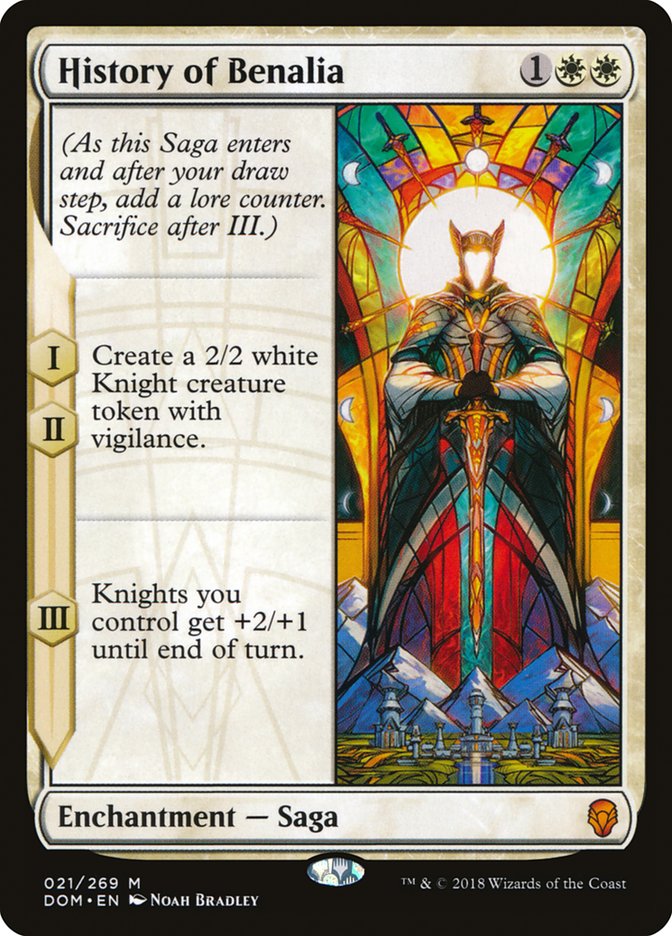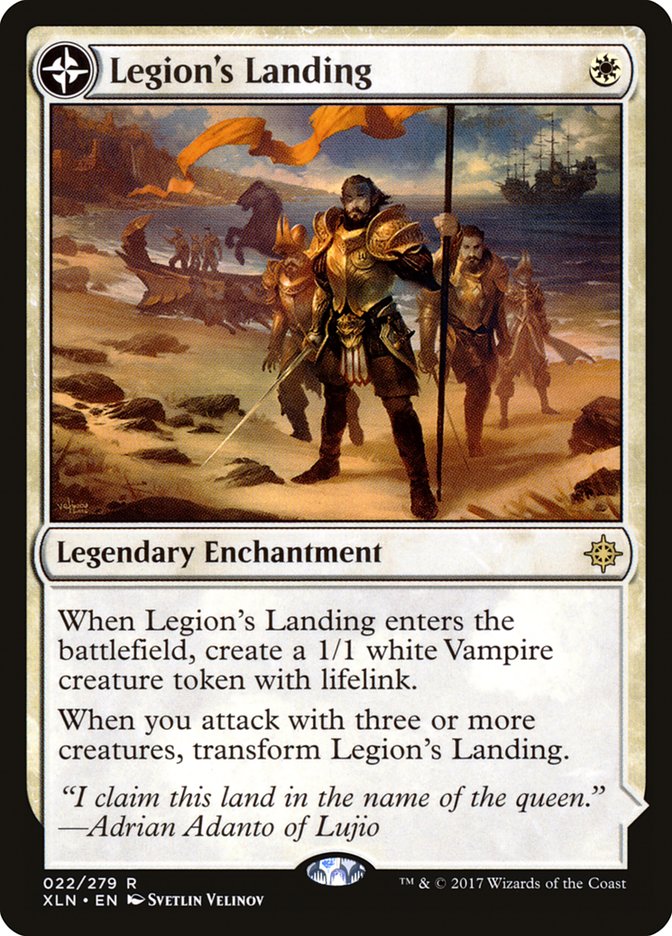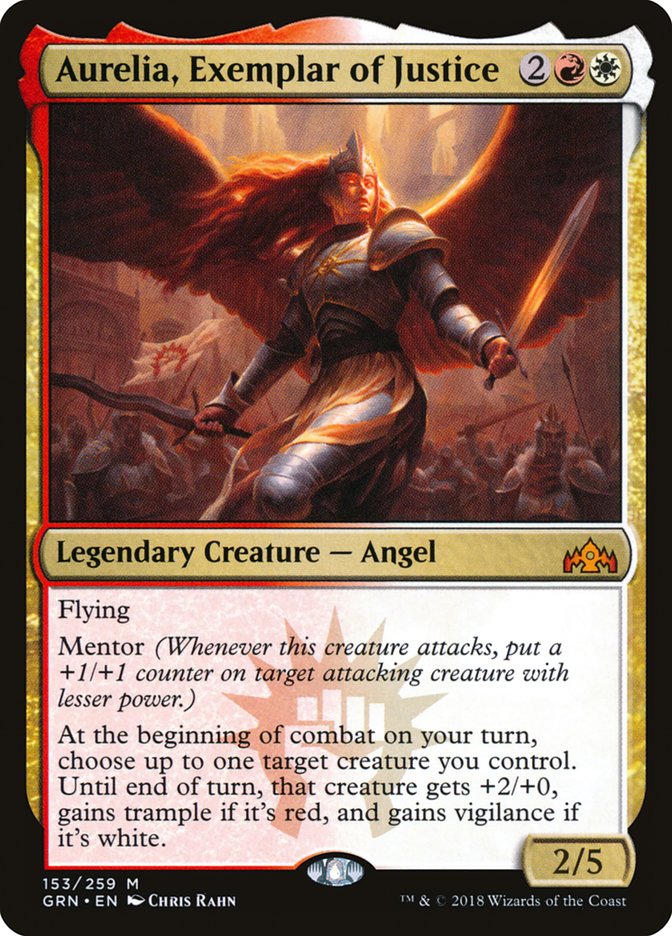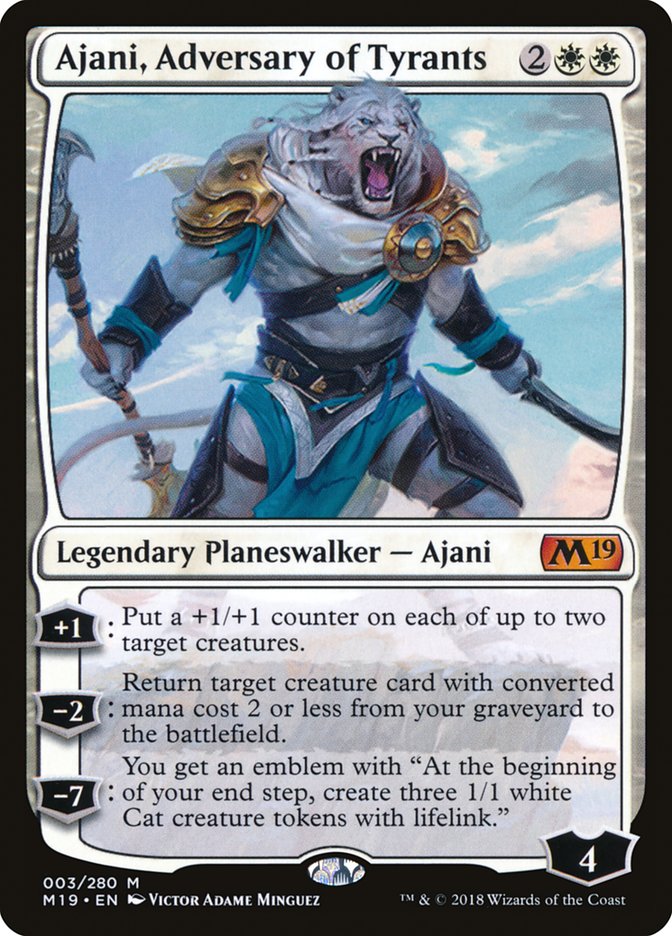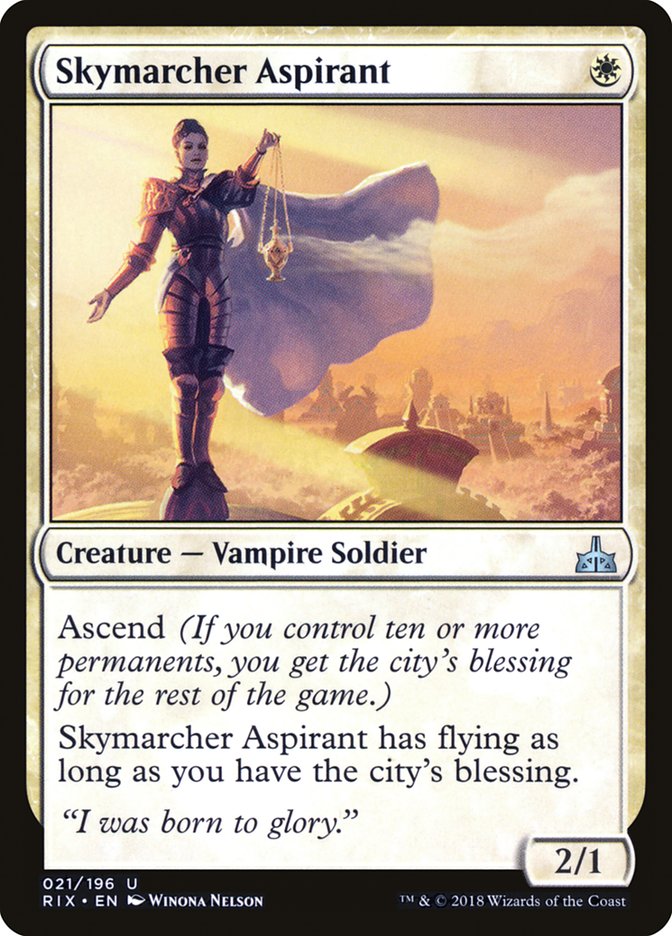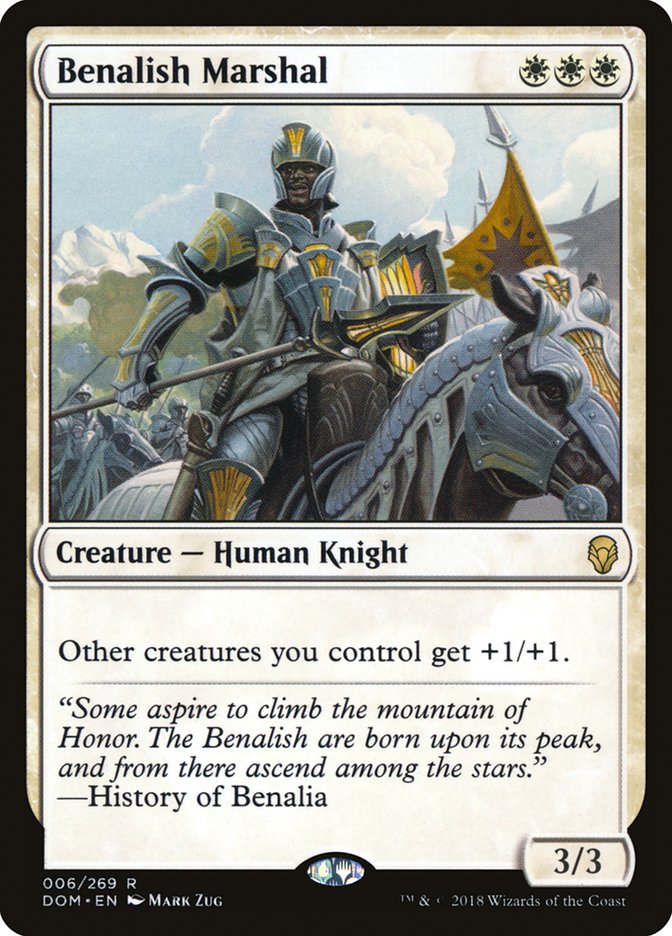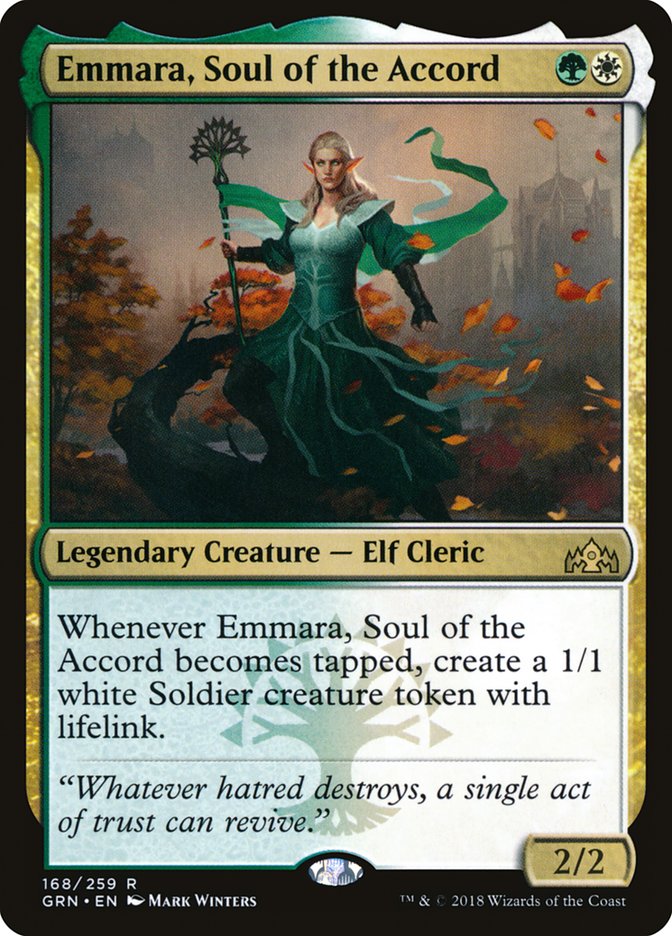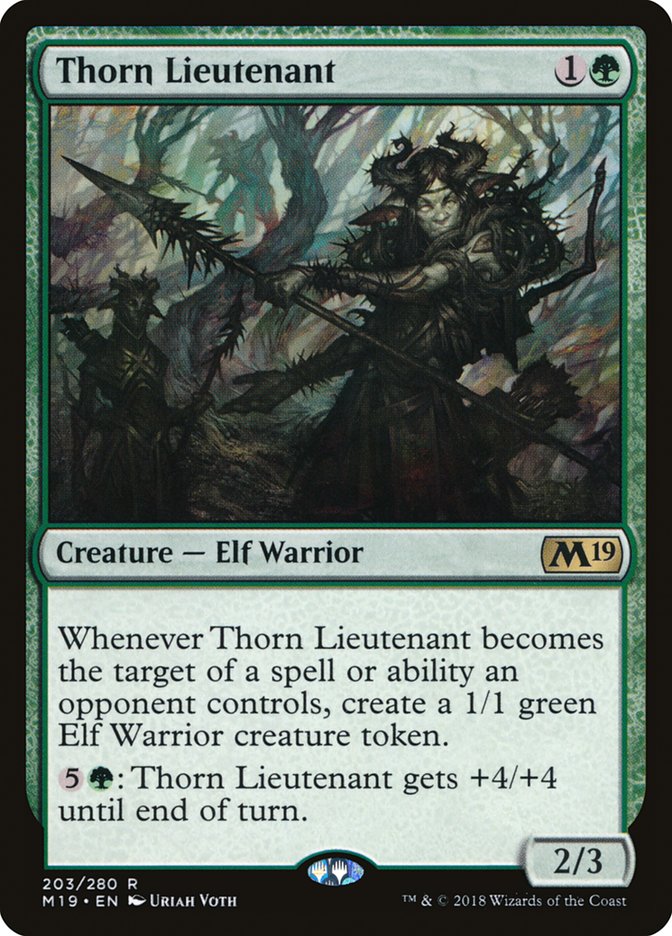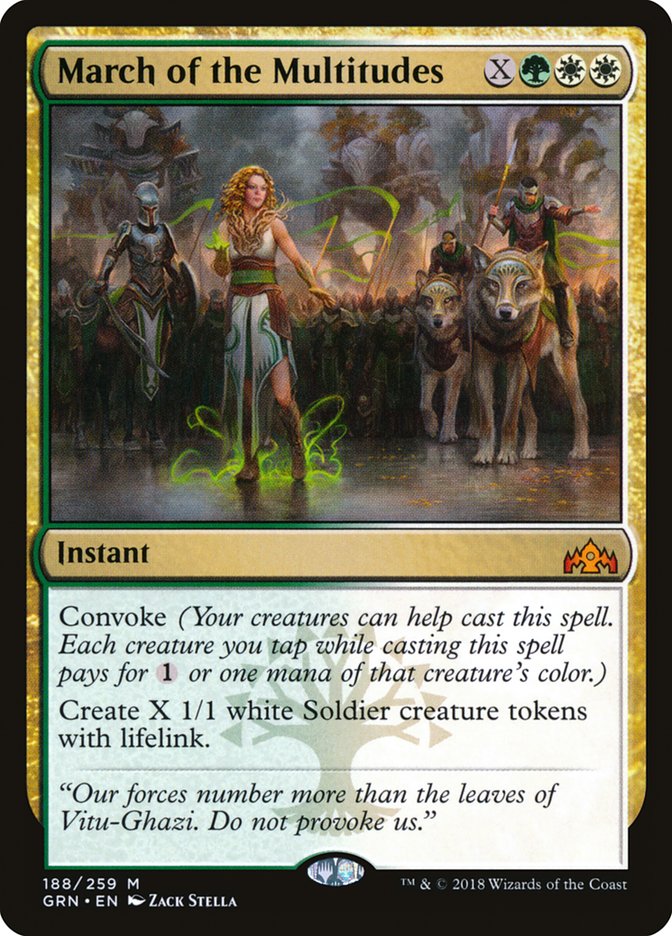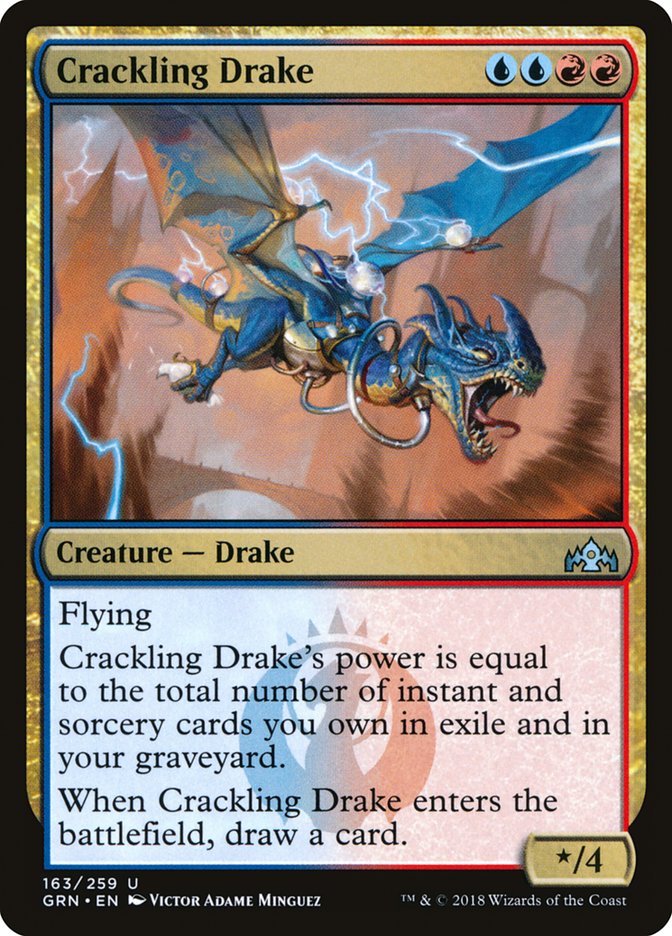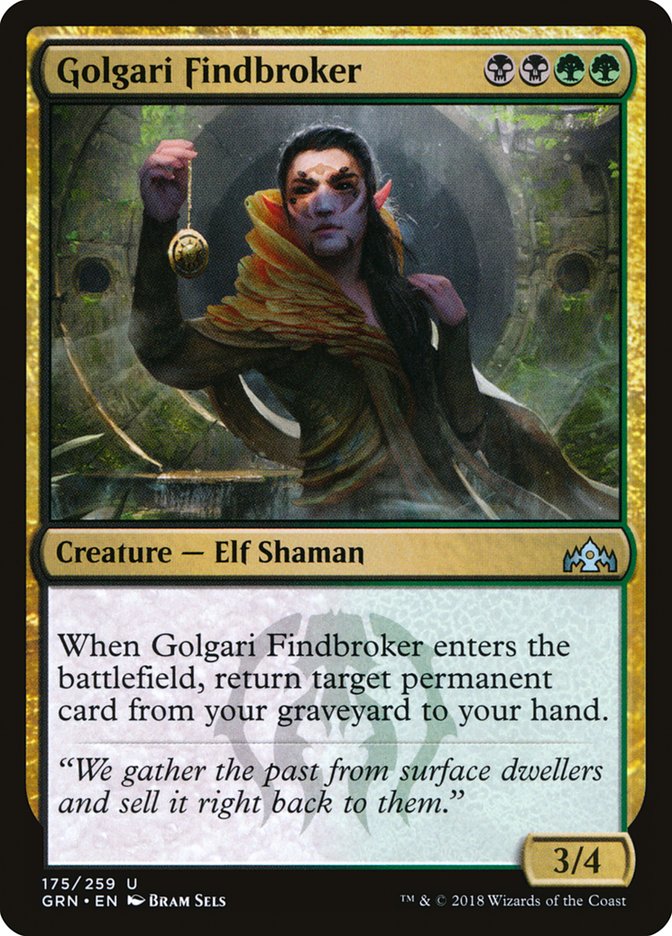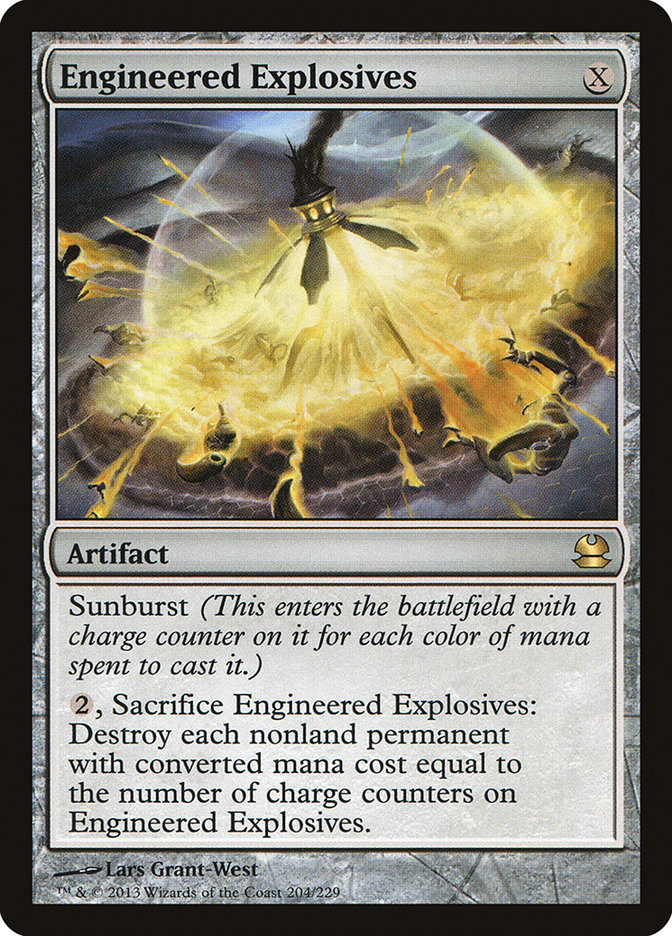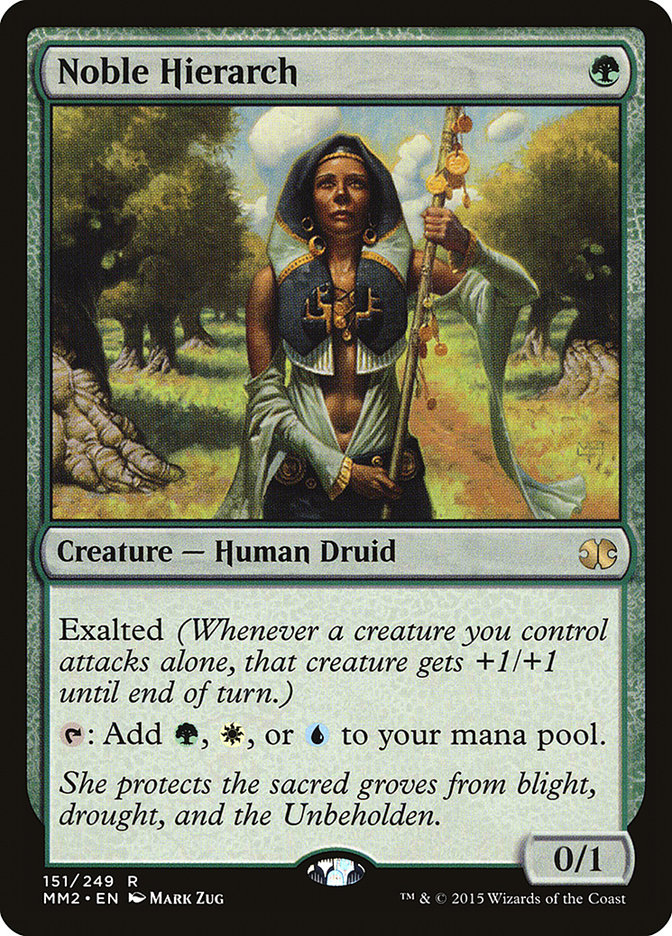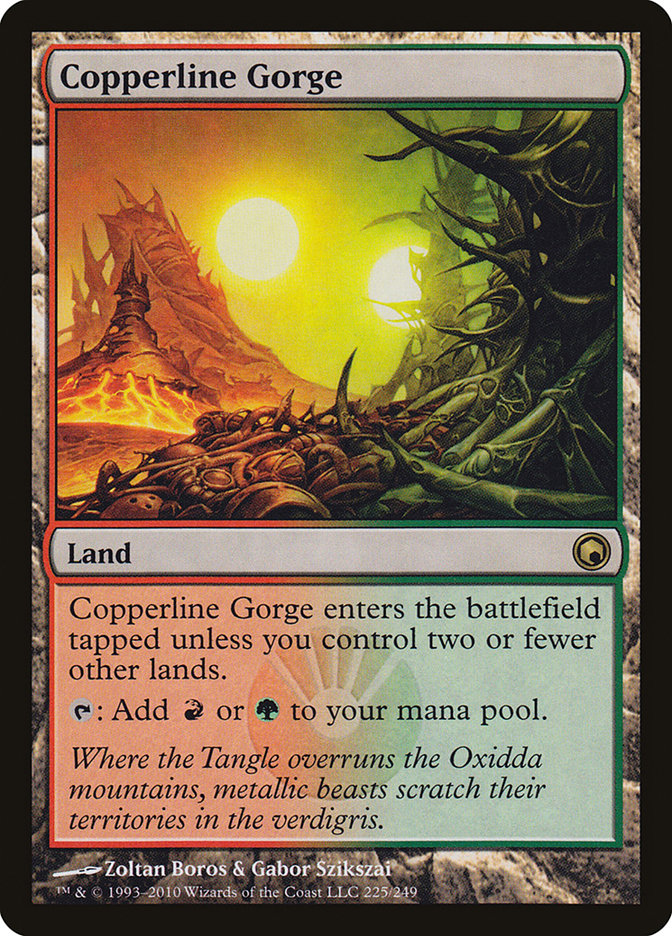Pro Tour Guilds of Ravnica
is finally in the books, and boy was it a weird event. What looked like a
very diverse metagame on Friday and Saturday turned into a Top 8 dominated
by six very similar white-based aggro decks. While writing this article, I
felt some kinship with those sports reporters who are 80% of the way
through their post-mortem of a big game only for the lead to change at the
very last minute.
But is White Aggro really the best deck in Guilds of Ravnica
Standard, and if so, what does that mean for the future of the Standard
market? Let’s dive into the Pro Tour results and see if we can predict
which cards are about to skyrocket in value – and which cards very much
aren’t.
Boros Aggro Was The Big Winner of the Pro Tour, And We Should
Expect Major Gains For Cards like History of Benalia and Benalish Marshal
Everybody likes a good narrative, and it’s going to be hard to write the
story of Pro Tour Guilds of Ravnica without starting with the
obvious: six of the Top 8 decks were white-based aggro and the only two
“diverse” decks were bounced in the quarterfinals. Regardless of how open
the format actually is – more on this later – it’s pretty clear that Boros
Aggro is really, really good.
It’s also worth noting that Boros Aggro is a fairly recent deck, too. It
certainly wasn’t unknown going into the Pro Tour – it dominated the MOCS
last weekend,
and Gerry Thompson (among others) wrote about it on StarCityGames last
week
– but it hadn’t shown up at a major tournament before its arrival at the
Pro Tour. If a better-known deck like Izzet Drakes or Golgari Midrange had
managed to put six decks into the Top 8, the financial gains would have
been smaller because the staples from those decks have been expensive for
quite a while already. But there’s some fairly fresh meat in Boros Aggro,
and we’re going to see some spikes this week due to the Pro Tour Top 8.
For one, History of Benalia has gained about 7 tickets on MTGO as of this
writing. The paper price hasn’t moved in several weeks, but I expect that
to change very soon. History of Benalia proved all weekend long that it was
one of the two or three most important cards in Standard, and it is
currently the only mythic rare in some builds of Boros Aggro. SCG is
currently out of stock at $26, and I doubt it’s re-stocked for anything
under $30 at this point. $35 is likely, and $40 is possible.
Legion’s Landing is also a card on the rise on MTGO. Not only is it a
crucial card in Boros Aggro, but it’s a four-of in most builds of Selesnya
Tokens. I wouldn’t be surprised if it ends up finally making it up to the
$10 level.
Aurelia, Exemplar of Justice is worth another look as well. It hasn’t seen
the kind of movement on MTGO that I’d expect before a major surge in the
world of paper Magic, but it’s an important mythic in these Boros decks and
its price has remained pretty robust throughout the first few weeks of Guilds of Ravnica Standard due to its place in Boros Angels. If it
ends up seeing play in two tier one decks, it should start to rise again.
I also feel like it might finally be time for Ajani, Adversary of Tyrants
to get a little frisky. The white Planeswalker was one of my favorite spec
targets heading into Guilds of Ravnica preview season, but it’s
been more or less sidelined for the first couple of weeks. Ajani has
started to pop up more and more, though, especially in the sideboard of
some of the Boros Aggro builds and even in the maindeck of some Selesnya
lists. It’s up about five tix on MTGO, and I’d expect the paper price to
follow suit. It’s not a major target for me, but it’s worth monitoring.
If you’re looking for a slightly safer spec, you can’t go wrong with
Skymarcher Aspirant. There are loads of these uncommons out there for less
than fifty cents right now, but that price isn’t going to last. Rivals of Ixalan was an unpopular small set, which means that even
an uncommon can end up in the $2-$3 range if enough people need a copy.
Considering the fact that this card is now a four-of in most if these
white-based aggro decks, I’m buying.
Lastly, we should talk about Benalish Marshal. Current retail on this one
is just $3 right now, and that’s going to change in an awful hurry. Goblin
Chainwhirler has bounced around between $5 and $10 since its breakout
performance back in the spring, and I feel like $5 is the new floor for
this other mono-colored powerhouse. It doesn’t have much play beyond Boros
Aggro, but that deck had so few rares or mythics in it that I expect its
staples to see some significant gains over the next couple of days. Make
sure your LGS doesn’t have a stack of these sitting around in their $1 box.
As always, you’re going to want to flip these cards as quickly as you can.
Pro Tour hype rarely lasts, and these cards should peak in price at some
point over the next week or so. If you’ve got any extra copies of History
of Benalia lying around, for example, wait for the price to spike at some
point over the next couple of days and then pounce.
…But Boros Aggro isn’t as Dominant as it Seems
Don’t forget: the Pro Tour isn’t solely a Standard event. There are ten
rounds of Standard as well as six rounds of Booster Draft. Here’s the
breakdown of all 70 decks that finished with at least a
7-3 record in the Standard portion of the event:

This list tells a very different story. While Boros Aggro still seems like
the best deck in the format – especially once you factor in that far fewer
players brought it to the Pro Tour than most of these other decks – it
doesn’t seem to be a full tier better than Golgari Midrange, Izzet Drakes,
or even Mono-Red Aggro.
And these figures more or less match up with
the current Standard metagame on MTGO
. While Golgari Midrange has been knocked down a peg and Boros Aggro pretty
clearly belongs in that #1 slot, the top three most popular decks on MTGO
right now were the same three decks that had the best finishes at the Pro
Tour. So, if you’re viewing this Pro Tour as some sort of major shift to
the balance of power in Standard, well, that just simply isn’t true.
And while I don’t expect any major gains to the staples in either Izzet
Drakes or Golgari Midrange due to Pro Tour fallout, I also doubt that we’re
going to see cards like Vivien Reid, Arclight Phoenix, Jadelight Ranger, or
Carnage Tyrant suddenly start to tank in value. Golgari Midrange and Izzet
Drakes may not grab any headlines this morning, but they did what they had
to do to remain top tier decks in Standard.
Control Needs to Find a New Way Forward, and Teferi Might Need a
New Home
Jeskai Control’s performance was one of the biggest disappointments of the
weekend. It was the fifth most popular deck on Day One, but it had the
worst conversion percentage (57%) of any deck in the metagame’s first or
second tier. Mono-Blue Aggro was the only other semi-popular deck that did
worse, and all the other tier one decks were at 63% or better.
Financially, this might be a big deal. Control decks tend to have more
expensive staples than aggro decks, and Jeskai certainly has its share of
pricey staples. Teferi, Ionize, Settle the Wreckage, Azor’s Gateway,
Rekindling Phoenix, Search for Azcanta…these are all among the most
sought-after cards in Standard. If Jeskai Control starts to wane in
popularity, all these cards might be in for a bit of a tumble.
So, what happened? To me, the problem is two-fold. One, the current crop of
aggro and midrange decks in Guilds of Ravnica Standard might be
too diverse for control decks to develop a solid gameplan against them.
What works well against Boros Aggro isn’t the same as what works well
against Izzet Drakes or Golgari Midrange.
Control can usually solve this problem in time, though, especially if the
tools are as good as they are in the current iteration of Standard. To me,
the bigger problem is just that the format keeps moving so fast that it’s
hard for control to keep up. Golgari Midrange is the deck to beat one week,
Izzet the next, and Boros Aggro the week after that. I’m not sure that I’ve
ever seen a Standard format move this fast, and since control decks are by
their nature reactive, they’ve had a hard time recently.
Both of these issues compound each other and together they do a good job of
explaining why Jeskai Control had a mediocre showing this weekend. But does
that mean control is DOA, or is it possible that Jeskai will be the deck to
beat at some point later this month?
Looking at the Day Two Conversion Percentages
, it’s pretty clear that it was kind of a rotten Pro Tour to be playing any
sort of control deck. Esper Control is the only brew that put up a decent
showing on Day One, with four of its five pilots making Day Two, but that’s
an incredibly small sample size and only one of those Esper pilots finished
the Standard portion of the event with at least seven wins.
Creatures (1)
Planeswalkers (7)
Lands (27)
Spells (25)

Odds are, control will be fine. There were four Jeskai Control decks with
at least 27 Standard match points, which puts it only a little behind
Golgari and Izzet Drakes among the tournament’s top finishers. But that
conversion rate remains a little worrying, and the fact that this is a
question at all should be moderately concerning for anyone with a lot of
expensive control cards lying around, and it’s very possible that we’ll see
some significant price drops before the new control hotness finally
emerges.
At the very least, Pro Tour Guilds of Ravnica seems like a pretty
major rebuke of the Azor’s Gateway + Expansion//Explosion plan, which had
led to some pretty nutty wins in the weeks leading up to the Pro Tour. I
don’t think Azor’s Gateway will drop all the way back to bulk mythic
status, but I’m selling all my extra copies as soon as I possibly can, even
though the card is currently on the decline. I’d rather get out while
there’s still a little bit of demand, even at a loss, rather than wait
until all the demand has vanished. None of the Jeskai Control decks that
had a high finish at the Pro Tour ran Azor’s Gateway at all, so I can’t
imagine the card remains above $5 for long.
As for Teferi, I’m holding for now. While I expect the price to drop a
little, I don’t think it’ll tank to the point where it’s worth selling only
to re-buy a bit later. Don’t forget: Azorius is going to be one of the
guilds in the winter expansion, and Teferi is one of those cards that’s
always a supporting piece or two away from being the best card in Standard.
Selesnya Tokens is Somehow Both Better And Worse Than We Think
If you watched the Pro Tour stream all weekend, you probably emerged from
the experience feeling like Selesnya was one of the better decks in
Standard. It was on camera a good amount of the time, and it looked pretty
good most of the time. Selesnya’s Day Two Conversion Percentage was also a
robust 77%, meaning that it had a better Day One than Boros Aggro did. In
fact, Selesnya had the highest conversion percentage of any deck with at
least ten pilots by a fairly wide margin.
On the other hand, only two Selesnya Tokens decks earned a place among the
70 Standard decks that finished the event with at least a 7-3 record. And
while this is roughly in line with the deck’s 3% metagame share on Day Two,
it still feels like a disappointing finish compared to that high conversion
percentage and all the favorable coverage that the deck enjoyed.
So, what happened here? Well, it’s a combination of three factors. One is
that the Selesnya players drafted well. The second is that Selesnya looked
like it had a decent edge against the Day One metagame that seemed to even
out on Day Two. The third is that there were some small sample size
shenanigans afoot, which made the deck seem like a bigger part of the
current metagame than it actually is. I mean, we’re talking about a deck
that only thirteen people brought to the Pro Tour, good for a whopping 2.5%
of the Day One metagame.
This is what I mean when I say that the deck is both better and worse than
we think. If you thought that Selesnya was a non-factor heading into the
Pro Tour, as many did, then Selesnya’s results might seem surprising. And
considering how well the deck did on Day One, I wouldn’t be surprised if it
ends up becoming a popular tier two metagame choice again somewhere down
the line.
On the other hand, don’t be fooled by the video coverage or the conversion
percentage numbers into thinking that Selesnya’s expensive staples are
about to rise in price. With all the dust settled, it’s pretty clear that
Selesnya is not a tier one deck right now. Cards like March of the
Multitudes and Thorn Lieutenant will likely continue to keep slowly losing
value over the next couple of weeks, and Selesnya should remain an
afterthought.
Guilds of Ravnica Standard Should Remain Popular (And
Expensive) For Many Months To Come
Standard Pro Tours usually go one of two ways. Often, a single dominant
deck shows up in force on Day One and the rest of the tournament becomes a
referendum on its success. Whether it ultimately gets the job done or not,
everybody watching realizes that they only have two real choices if they
want to win: play the best deck in the format or play whatever beats it.
And then there are those tournaments where a new piece of tech ripples
across the room and throws the metagame into chaos. This new deck is
usually great against the dominant strategy, has a great Day Two conversion
percentage, and throws at least a couple of its pilots into the Top 8.
Pro Tour Guilds of Ravnica
followed this second script far more than the first. Golgari Midrange was
the most popular deck on Day One, but it was far from dominant and the
format hasn’t been warped around it in a “beat me or else” sort of way. And
while the true power of Boros Aggro didn’t make itself clear until late in
Day Two, the fact that it dominated the Top 8 more than made up for the
deck’s delayed emergence.
But despite the fact that we seem to have been to this hotel before, I
still don’t see this weekend’s results as the end point for this particular
Standard format. Every time this format has seemed “solved” over the past
couple of weeks, there’s been another shift in the metagame to adjust. And
despite how great the Boros Aggro decks looked on Sunday, I expect the
format to adjust, and adjust, and adjust again. This Standard format is
both diverse and exciting enough to remain popular – and for most of your
expensive staples to remain valuable – despite the dominance of Boros Aggro
on Sunday.
See, Standard prices tend to peak during the week directly following a Pro
Tour because that’s when we finally “know what’s good.” They tend to start
dropping off pretty quickly after that, though. The format starts to get
stale, people get bored, and Standard demand starts slowing to a trickle
before the next set comes along to shake things up. Prices also suffer
because more and more packs of the latest set are opened, which increases
the supply relative to demand. Plus, most dedicated Standard players are
already locked into a deck or two at this point.
diverse and fluid, fewer people will give up on the format for being stale,
and the overall demand for Standard cards should remain high all winter
long.
I still expect this drop-off to happen to Guilds of Ravnica
Standard – people are getting locked into specific decks, and more packs
will be opened – but I expect it to be a far less extreme drop than it has
been in the past, especially in recent months. Because this Standard
metagame is still so diverse and fluid, fewer people will give up on the
format for being stale, and the overall demand for Standard cards should
remain high all winter long.
This Week’s Trends
-
Over in Modern, we’re starting to see the effect that Ultimate Masters is going to have on the market.
Engineered Explosives, Noble Hierarch, Karn Liberated, Cavern of
Souls, Gaddock Teeg, and Through the Breach are all down at least
$5, and those losses will continue to pile up. Despite all the
hand-wringing over the MSRP increase, Ultimate Masters
boxes have been selling really well so far – a trend that I expect
to continue.
-
There haven’t been too many Modern gains this week, but Copperline
Gorge has continued to surge in price as more and more people
realize that Dredge is here to stay. You need four copies of this Scars of Mirrodin land in order to play the deck, and it
seems pretty likely that this cycle will not be in Ultimate Masters. Feel free to snag these if you need
them, but be aware that they’ll almost certainly be reprinted in
Standard at some point over the next couple of years. -
We’ll get into this in depth at some point soon, but right now it’s
worth noting that the Reserved List index is down pretty
significantly from its high-water mark back in early September.
There was always going to be some regression here, but it’s still
kind of unclear if this pullback is more of a reaction to the
prices having gotten too crazy or if people have been simply too
focused on Standard recently to think much about $800 Legends cards. Regardless, there are some deals to be had
right now if you’re in the market for power or dual lands. -
Lastly, WotC is teasing a
pretty major organized play announcement
in early December. There’s speculation about everything from an
Arena-exclusive Pro Tour to a brand new “post Modern” Eternal
format.
While I don’t want to spend too much time guessing about this without
knowing more, I do expect that we’ll see a new format at some point, and I
expect Kaladesh and Amonkhet blocks to be included in
that new format since they’re already programmed into Arena. You might want
to get ahead of the rush and pick up some of these staples now, while very
few people are thinking about cards like Hazoret the Fervent and The Scarab
God.


